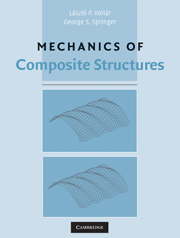Book contents
- Frontmatter
- Contents
- Preface
- List of Symbols
- 1 Introduction
- 2 Displacements, Strains, and Stresses
- 3 Laminated Composites
- 4 Thin Plates
- 5 Sandwich Plates
- 6 Beams
- 7 Beams with Shear Deformation
- 8 Shells
- 9 Finite Element Analysis
- 10 Failure Criteria
- 11 Micromechanics
- Appendix A Cross-Sectional Properties of Thin-Walled Composite Beams
- Appendix B Buckling Loads and Natural Frequencies of Orthotropic Beams with Shear Deformation
- Appendix C Typical Material Properties
- Index
10 - Failure Criteria
Published online by Cambridge University Press: 01 September 2009
- Frontmatter
- Contents
- Preface
- List of Symbols
- 1 Introduction
- 2 Displacements, Strains, and Stresses
- 3 Laminated Composites
- 4 Thin Plates
- 5 Sandwich Plates
- 6 Beams
- 7 Beams with Shear Deformation
- 8 Shells
- 9 Finite Element Analysis
- 10 Failure Criteria
- 11 Micromechanics
- Appendix A Cross-Sectional Properties of Thin-Walled Composite Beams
- Appendix B Buckling Loads and Natural Frequencies of Orthotropic Beams with Shear Deformation
- Appendix C Typical Material Properties
- Index
Summary
Failure of fiber-reinforced composites may be caused by fiber buckling, fiber breakage, matrix cracking, delamination, or by a combination of these factors (Fig. 10.1). Local fiber buckling, or microbuckling, reduces the compressive stiffness and strength of the laminate. Microbuckling does not necessarily lead to immediate failure because the surrounding matrix supports the fibers. The properties of the fibers and the matrix greatly affect the onset and magnitude of fiber buckling and the resulting losses in the compressive properties of the laminate.
One of the main roles of the fibers is to carry tensile loads. When dry fibers (with no matrix surrounding them) break, they, of course, can no longer carry tensile loads. When the fibers are embedded in a matrix, the matrix acts as a bridge about the break and transmits the load across the gap created by the breakage as well from the broken to the adjacent fibers. Fiber bridging, as this phenomenon is called, is the main reason that the tensile strengths of unidirectional, continuous fiber-reinforced composites are higher than the tensile strengths of dry fiber bundles.
Matrix cracking frequently occurs in composite laminates. In itself, matrix cracking generally does not result in ultimate failure of a laminate. Nonetheless, matrix cracks have many detrimental effects: they facilitate moisture absorbtion, reduce the matrix-dominated stiffnesses of the laminate and, last but not least, may propagate into the interface between adjacent layers, initiating delamination.
- Type
- Chapter
- Information
- Mechanics of Composite Structures , pp. 411 - 435Publisher: Cambridge University PressPrint publication year: 2003

